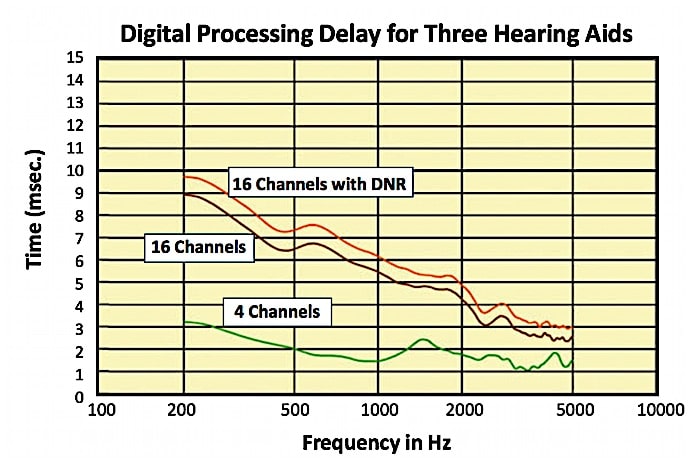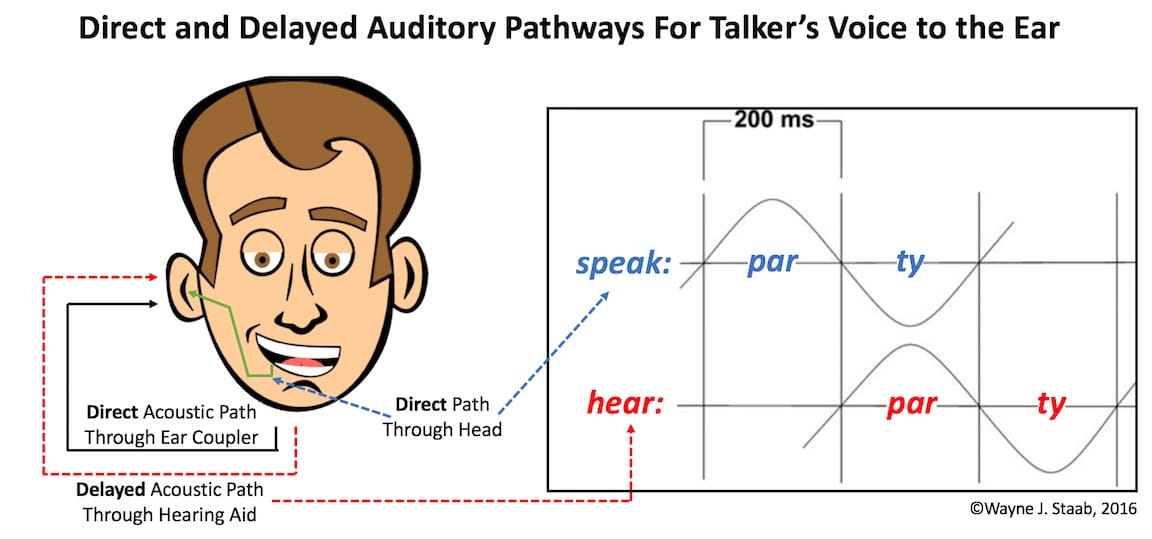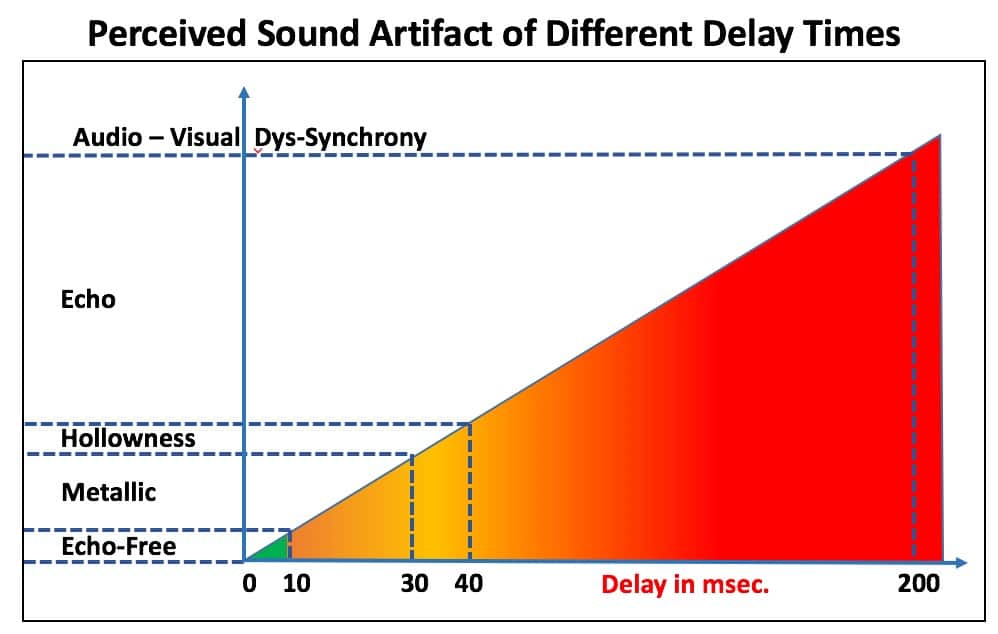Hearing Aid Delay Between Direct and Processed Sound
Last week’s post provided information about the delay between the direct and processed sound in digital hearing aids – hearing aid delay. All hearing aids, but especially digital, have processing delays and it has been speculated that these delays may potentially interfere with amplified sound quality of speech. Depending on the amount of delay, the result could be audible, objectionable, or even result in auditory confusion.
The questions to be asked are: how much delay can be expected, is this delay noticeable to the hearing aid wearer, and if so, what impact might it have? This delay is measured as group delay or processing delay. This delay is the time involved from the initial stimulus reception by the hearing aid until it is processed and delivered to the hearing aid speaker/receiver. In electrical or audio circuits, the term phase is used to describe the difference in time displacement of one signal relative to another, and group delay expresses the relative delay of the different frequencies in a complex waveform. This delay can be perceived as an echo by the person wearing a hearing aid and listening to his/her own voice.
Delay and Hearing Aids

Figure 1. Digital processing delay for three different hearing aids. The fewer “features,” the shorter the processing (group delay) time. (DNR = Digital Noise Reduction). (Modified from Herbig and Chalupper, 2010).
What was not mentioned last week however, is that as more features are added to the hearing aid, the total group delay can increase (Herbig and Chalupper, 2010). For example, group delay can increase with a greater number of channels, more advanced digital noise reduction and feedback systems, etc. (Figure 1). Additionally, the type of earmold coupling (closed versus vented/open), and how the signal processing occurs may also a factor. Some signal processing and frequency analyses use filter banks (sample by sample with bandwidth of the channels varying across frequency) or FFT (Fast Fourier Transformation that processes a block of samples at once, but with bandwidth that remains the same across frequency). Regardless of the method used, as the spectral resolution is increased, temporal resolution decreases. What this means is that the greater number of channels (narrower channels), the longer the group delay.
Digital signal processing (DSP) hearing aids can have delays of up to several hundred milliseconds, depending on the particular architectures and algorithms used to achieve the desired signal processing (Agnew and Thornton, 2000).
Delay Paths for Hearing Aids
According to Agnew and Thornton (2000), delay for hearing aids can take several paths from the hearing aid wearer to his/her ear when speaking (Figure 2):
- Slit leak – Direct acoustic pathway though the hearing aid coupling earpiece
- Vent – Direct acoustic pathway through a vent in the earmold or coupling earpiece
- Pathways inside the head – Direct acoustic transmission pathways via bone-conduction, conduction through soft tissue, through the eustachian tube and middle ear
- DSP – Time delayed acoustic pathway caused by the signal passing through digital signal processing.

Figure 2. Illustration showing direct acoustic pathways for a talker’s voice through the air, and through the head (solid black and green lines), along with the delayed pathway through a DSP hearing aid to the ear (dashed line). On the right is shown delay causing maximum auditory confusion at 200 msec. delay.
Studies have been conducted to determine what impact, if any, results from hearing aid digital signal processing delay.
How Long is the Delay in Current Digital Hearing Aids?
In 1999, Moser measured the delay for contemporary properly functioning digital hearing aids and found the delay to be between 2 and 10 msec. No more recent results have been found for year 2016 hearing aids with their multiple combinations of features.
Hearing aid engineers have often mentioned to this author that the more features activated in a hearing aid, the less is know about what it is actually doing when all the parameters are operating at the same time. And, what about hearing aids that are not functioning properly?
Might there be some phase/delay issues that arise?
Can Delay Be Noticeable in Digital Hearing Aids?
Sufficient evidence exists that it can be noticeable. In fact, use of delay in hearing diagnostics has existed as early as 1991 (Silman and Silverman), using the effects of delayed auditory feedback (DAF) in clinical testing. Depending on the delay time, auditory confusion results (stuttering and other speech degradation), especially when the talker’s voice reaches their ears through a combination of direct and delayed pathways. Such auditory confusion has been reported to occur with as little as a 20 msec. delay, with maximum disruption at 200 msec. (Agnew and Thornton, 2000).
How Has Delay Been Reported in Hearing Aid Studies?
Figure 3 shows the results from studies that have attempted to define consumer perceptions as they relate to delay times.

Figure 3. Hearing aid delay and listening perceptions.
There is little doubt that even very short time delays can be noticeable in a received sound. However, if modern hearing aids have time delays shorter than 10 msec., it is unlikely that this would create audio-visual confusion. Still, some hearing aids may have delays that cause “coloration” of the sound delivered to the ear as illustrated in Figure 4, especially if they are malfunctioning.

Figure 4. Perceptual consequences of different delay times. Delays shorter than about 10 msec. between the direct and processed sound are echo-free. Delays between about 10 and 30 msec. result in a metallic sound quality, and delays between about 30 and 40 msec. are perceived as having a hollow sound quality. Delays longer than about 200 msec. result in maximum disruption (audio-visual confusion/dys-synchrony, stuttering, and other speech degradation).
Does Delay Affect Open Canal or Other Fittings?
This will be a topic for a future post.
References
Agnew J. (1997). An overview of digital signal processing in hearing instruments. Hear Rev 4(7):8, 12, 16, 18, 66.
Agnew J, Thornton JM. (2000). Just noticeable and objectionable group delays in digital hearing aids. J Am Acad Audiol, 11, 330-336.
Moser LM. (1999). Electro-acoustic Measurements of Hearing Aids with Digital Signal Processing – What is Needed in Addition to the Standards IEC-118 and ANSI-322? Poster session presented at the Hearing Aid Amplification for the New Millennium Conference, Sydney, Australia, November 15-19.
Silman S, Silverman CA. . (1991).. Auditory Diagnosis: Principles and Applications. San Diego: Academic Press.
Stone M.A., Moore BCJ. (1989). Tolerable hearing aid delays. I. Estimation of limits imposed by the auditory path alone using simulated hearing losses. Ear & Hearing, 20:182-192.
Summerfield Q. (1992). Lipreading and audio-visual speech perception. Philos Trans R Soc Lond B Biol Sci 335:71-78.
About the author
Wayne Staab, PhD, is an internationally recognized authority in hearing aids. As President of Dr. Wayne J. Staab and Associates, he is engaged in consulting, research, development, manufacturing, education, and marketing projects related to hearing. His professional career has included University teaching, hearing clinic work, hearing aid company management and sales, and extensive work with engineering in developing and bringing new technology and products to the discipline of hearing. This varied background allows him to couple manufacturing and business with the science of acoustics to bring innovative developments and insights to our discipline. Dr. Staab has authored numerous books, chapters, and articles related to hearing aids and their fitting, and is an internationally-requested presenter. He is a past President and past Executive Director of the American Auditory Society and a retired Fellow of the International Collegium of Rehabilitative Audiology.
**this piece has been updated for clarity. It originally published on January 19, 2016








A good insight ! It helps understand why impaired listeners find it confusing , especially in babble type environments.
The delay (80ms) is the price we have to pay for “technological interference” between the algorithms.
Under such circumstances we should switch to NAL-R formula, and you will find a huge drop in hollowness, own voice adaptation, and metallic overtones.
Once adaptation is occurring well, we can transition the patient back to compressive formulas, using least compression initially. Point to note is that slow release times are no challenges to those patients who have good cognition, because the hippocampus only needs hints of flowing verse, to activate the memory centers in the brain.
Delayed re-transmission through the hearing aids leads to poor prognosis for patients suffering from diabetes, and hypertension.